A Comparative Analysis of Contractual Employment in HR Management
VerifiedAdded on 2023/01/04
|12
|3665
|66
Report
AI Summary
This report provides a detailed analysis of contractual employment models within human resource management. It begins by defining different types of employment contracts, including permanent full-time, permanent part-time, zero-hours casual, and fixed-term temporary contracts. For each model, the report outlines advantages and disadvantages, offering a comprehensive understanding of their implications. The report then shifts its focus to practical application, comparing how two distinct organizations, Amazon and Sports Direct, adapt and implement these contractual approaches. This comparative analysis highlights the diverse strategies employed by companies in managing their workforce through various employment models and provides a comprehensive overview of the subject matter.
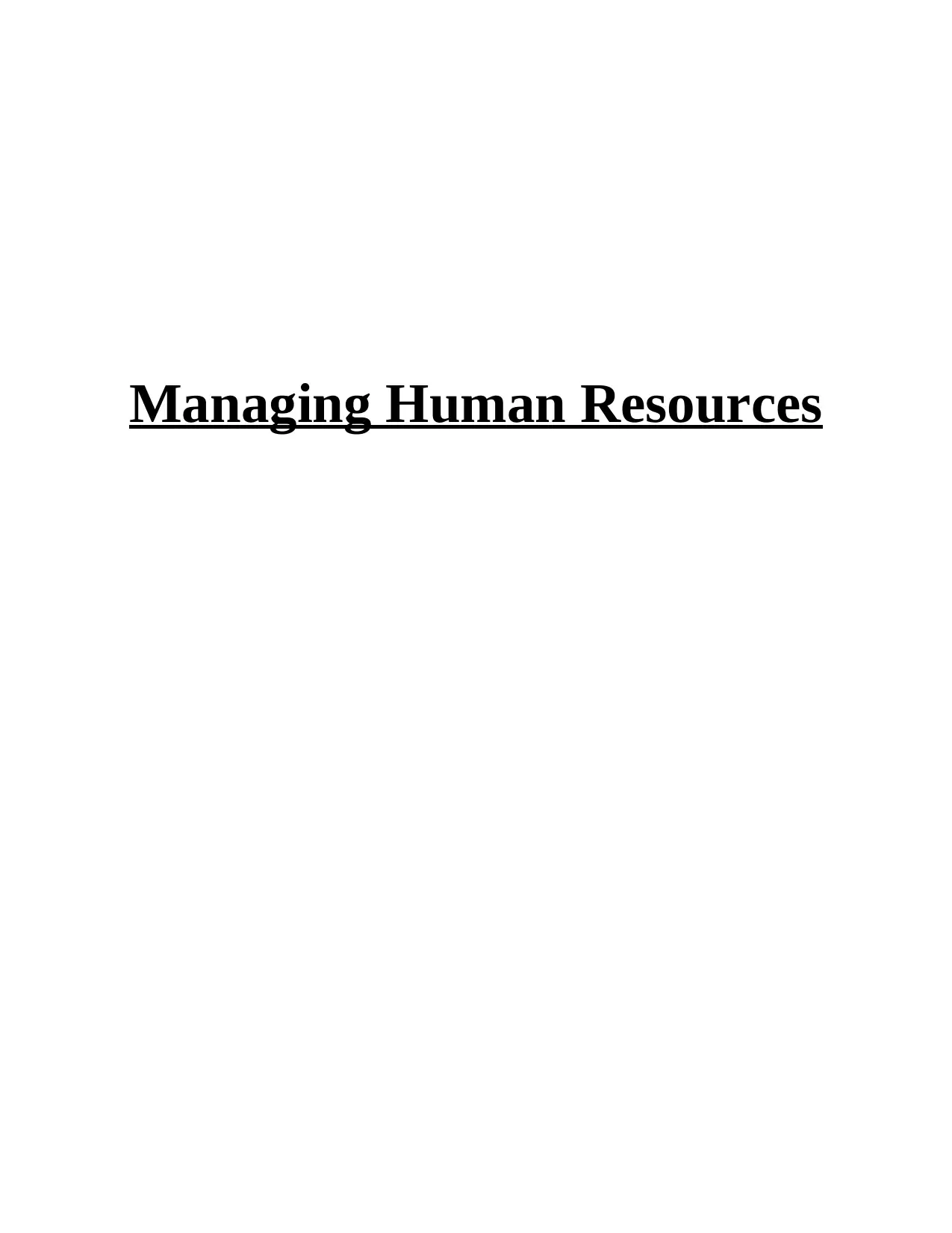
Managing Human Resources
Paraphrase This Document
Need a fresh take? Get an instant paraphrase of this document with our AI Paraphraser

Table of Contents
INTRODUCTION...........................................................................................................................3
Contractual models of employment:............................................................................................3
Adaptation of contractual approached by two different organisations and how they implement
them..............................................................................................................................................7
CONCLUSION..............................................................................................................................10
REFERENCES................................................................................................................................1
INTRODUCTION...........................................................................................................................3
Contractual models of employment:............................................................................................3
Adaptation of contractual approached by two different organisations and how they implement
them..............................................................................................................................................7
CONCLUSION..............................................................................................................................10
REFERENCES................................................................................................................................1

INTRODUCTION
Management of the human resource is a strategical process which is carried out
efficiently by the HR personal in managing the members and employees within the organisation.
They encourages the people of the company to work effectively and with full dedication to help
attain higher productivity and growth in comparison with their competitors. They emphasise on
enhancing staff performance and skills by applying various techniques. Human resource are
accountable for the accomplishment of recruitment and selection of talented workers which adds
up in the company growth. They manage all the organisational activities and also conduct
training sessions and look after employee benefits and rights. The following report will analyse
the different methods of employment done on contractual base and discuss their effectiveness
and the positive and negative impact they reflect on different organisations. Further it will
conduct evaluation by the differentiation made on the basis of different organisation and what
kind of employment method they follow.
Contractual models of employment:
This basically defines the different type of employment, organisations are following in
order to maintain and manage their workforce. This method facilitate the employer with
flexibility in employment as they can hire the workforce according to their need and demands of
the company. This contractual business is basically classified in various categories and they are
as follows:
Permanent full time contracts:
This refers to a contract which is imperishable in nature and will not end until the worker
wanted to leave the job or the employer decide to terminate the staff. In some cases the company
provide a certain contract to their staff members which will revived with time (Andrew Eldred,
2018). Management invest all of their beneficial resources and conduct training and
development session for their fixed term workforce in order to enhance their skills and transform
them into efficient workers. These employees need to work 6 days or in some organisation 5
days a week for 8-9 hours a day and sometime in rotating shifts.
Advantages
Management of the human resource is a strategical process which is carried out
efficiently by the HR personal in managing the members and employees within the organisation.
They encourages the people of the company to work effectively and with full dedication to help
attain higher productivity and growth in comparison with their competitors. They emphasise on
enhancing staff performance and skills by applying various techniques. Human resource are
accountable for the accomplishment of recruitment and selection of talented workers which adds
up in the company growth. They manage all the organisational activities and also conduct
training sessions and look after employee benefits and rights. The following report will analyse
the different methods of employment done on contractual base and discuss their effectiveness
and the positive and negative impact they reflect on different organisations. Further it will
conduct evaluation by the differentiation made on the basis of different organisation and what
kind of employment method they follow.
Contractual models of employment:
This basically defines the different type of employment, organisations are following in
order to maintain and manage their workforce. This method facilitate the employer with
flexibility in employment as they can hire the workforce according to their need and demands of
the company. This contractual business is basically classified in various categories and they are
as follows:
Permanent full time contracts:
This refers to a contract which is imperishable in nature and will not end until the worker
wanted to leave the job or the employer decide to terminate the staff. In some cases the company
provide a certain contract to their staff members which will revived with time (Andrew Eldred,
2018). Management invest all of their beneficial resources and conduct training and
development session for their fixed term workforce in order to enhance their skills and transform
them into efficient workers. These employees need to work 6 days or in some organisation 5
days a week for 8-9 hours a day and sometime in rotating shifts.
Advantages
⊘ This is a preview!⊘
Do you want full access?
Subscribe today to unlock all pages.

Trusted by 1+ million students worldwide
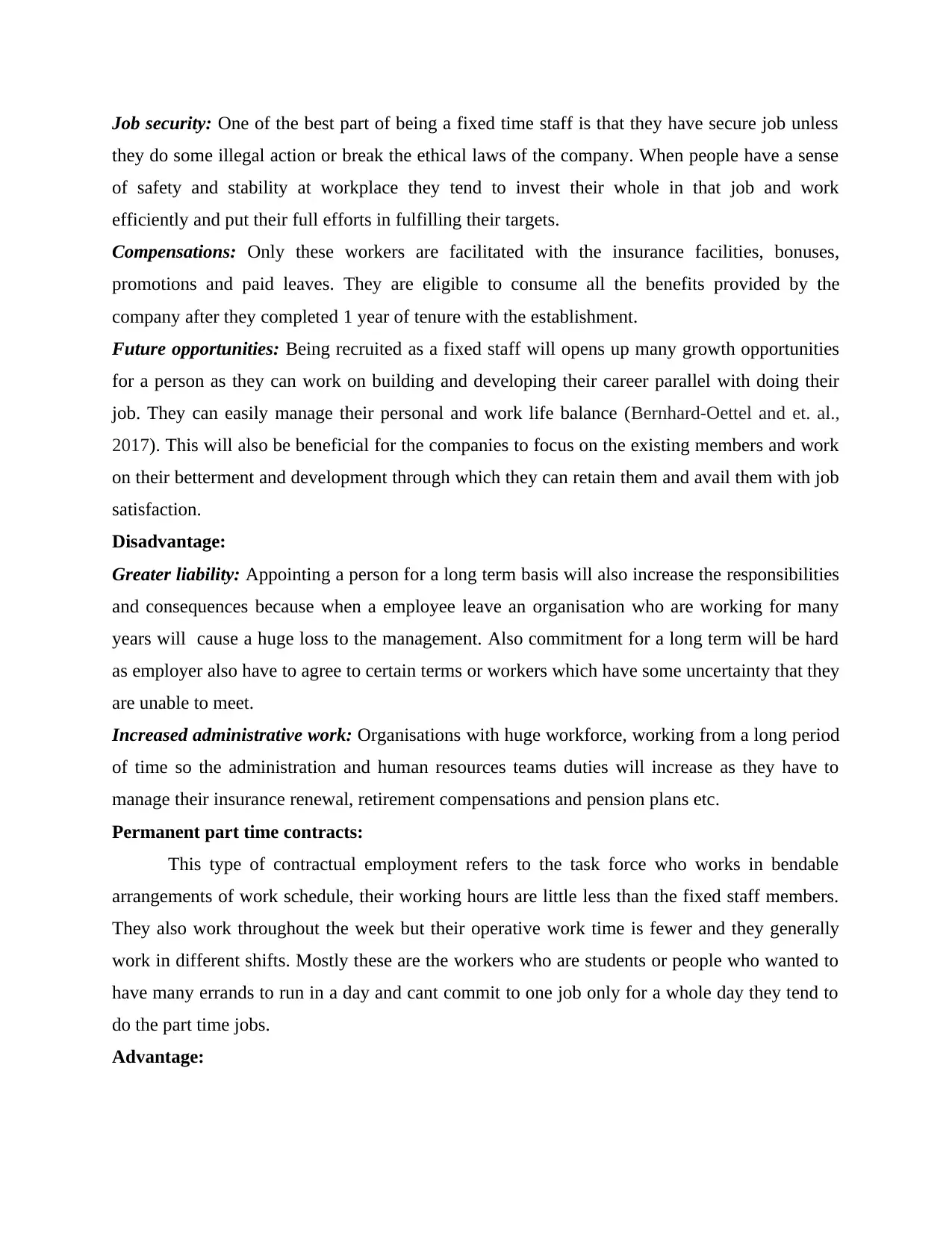
Job security: One of the best part of being a fixed time staff is that they have secure job unless
they do some illegal action or break the ethical laws of the company. When people have a sense
of safety and stability at workplace they tend to invest their whole in that job and work
efficiently and put their full efforts in fulfilling their targets.
Compensations: Only these workers are facilitated with the insurance facilities, bonuses,
promotions and paid leaves. They are eligible to consume all the benefits provided by the
company after they completed 1 year of tenure with the establishment.
Future opportunities: Being recruited as a fixed staff will opens up many growth opportunities
for a person as they can work on building and developing their career parallel with doing their
job. They can easily manage their personal and work life balance (Bernhard‐Oettel and et. al.,
2017). This will also be beneficial for the companies to focus on the existing members and work
on their betterment and development through which they can retain them and avail them with job
satisfaction.
Disadvantage:
Greater liability: Appointing a person for a long term basis will also increase the responsibilities
and consequences because when a employee leave an organisation who are working for many
years will cause a huge loss to the management. Also commitment for a long term will be hard
as employer also have to agree to certain terms or workers which have some uncertainty that they
are unable to meet.
Increased administrative work: Organisations with huge workforce, working from a long period
of time so the administration and human resources teams duties will increase as they have to
manage their insurance renewal, retirement compensations and pension plans etc.
Permanent part time contracts:
This type of contractual employment refers to the task force who works in bendable
arrangements of work schedule, their working hours are little less than the fixed staff members.
They also work throughout the week but their operative work time is fewer and they generally
work in different shifts. Mostly these are the workers who are students or people who wanted to
have many errands to run in a day and cant commit to one job only for a whole day they tend to
do the part time jobs.
Advantage:
they do some illegal action or break the ethical laws of the company. When people have a sense
of safety and stability at workplace they tend to invest their whole in that job and work
efficiently and put their full efforts in fulfilling their targets.
Compensations: Only these workers are facilitated with the insurance facilities, bonuses,
promotions and paid leaves. They are eligible to consume all the benefits provided by the
company after they completed 1 year of tenure with the establishment.
Future opportunities: Being recruited as a fixed staff will opens up many growth opportunities
for a person as they can work on building and developing their career parallel with doing their
job. They can easily manage their personal and work life balance (Bernhard‐Oettel and et. al.,
2017). This will also be beneficial for the companies to focus on the existing members and work
on their betterment and development through which they can retain them and avail them with job
satisfaction.
Disadvantage:
Greater liability: Appointing a person for a long term basis will also increase the responsibilities
and consequences because when a employee leave an organisation who are working for many
years will cause a huge loss to the management. Also commitment for a long term will be hard
as employer also have to agree to certain terms or workers which have some uncertainty that they
are unable to meet.
Increased administrative work: Organisations with huge workforce, working from a long period
of time so the administration and human resources teams duties will increase as they have to
manage their insurance renewal, retirement compensations and pension plans etc.
Permanent part time contracts:
This type of contractual employment refers to the task force who works in bendable
arrangements of work schedule, their working hours are little less than the fixed staff members.
They also work throughout the week but their operative work time is fewer and they generally
work in different shifts. Mostly these are the workers who are students or people who wanted to
have many errands to run in a day and cant commit to one job only for a whole day they tend to
do the part time jobs.
Advantage:
Paraphrase This Document
Need a fresh take? Get an instant paraphrase of this document with our AI Paraphraser
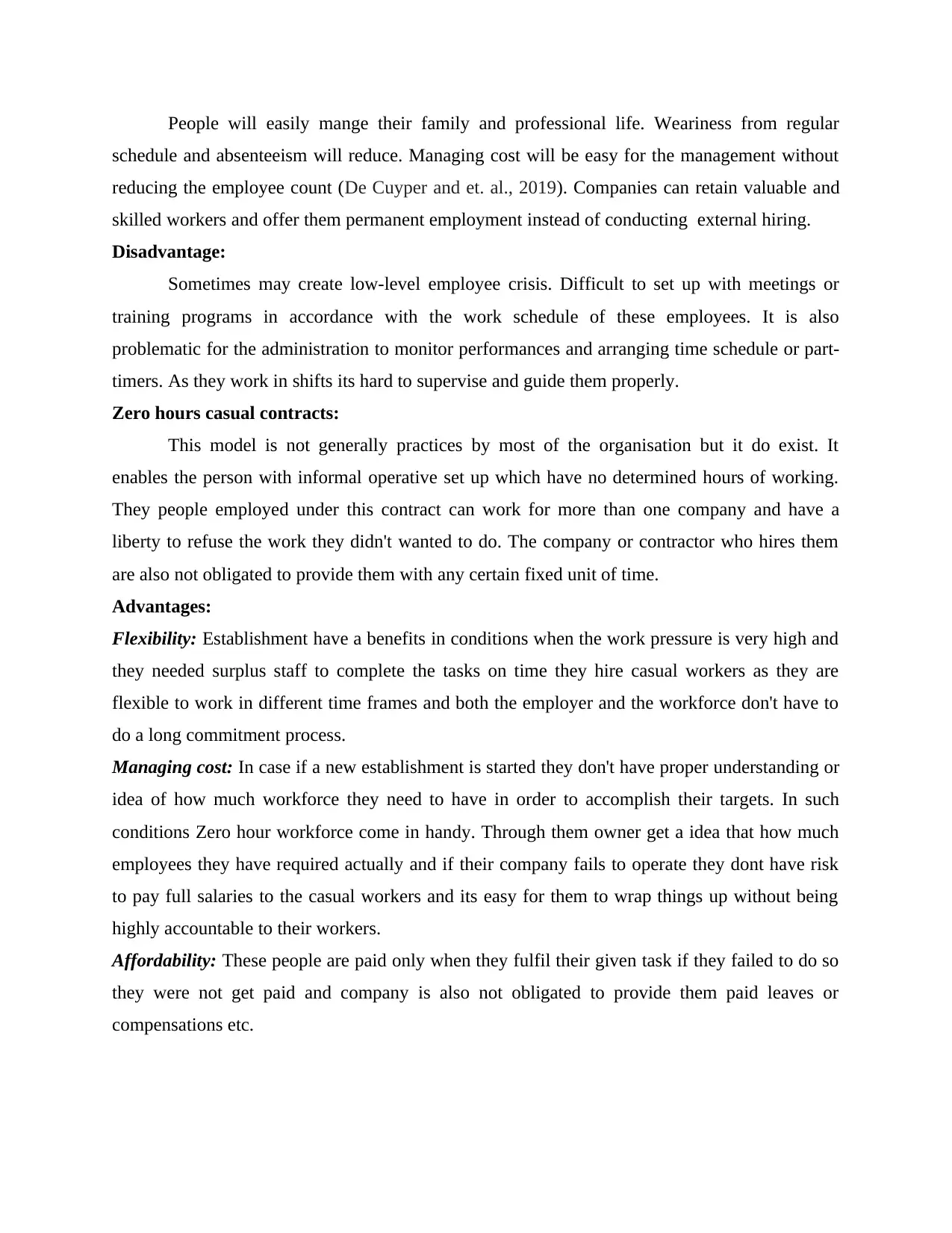
People will easily mange their family and professional life. Weariness from regular
schedule and absenteeism will reduce. Managing cost will be easy for the management without
reducing the employee count (De Cuyper and et. al., 2019). Companies can retain valuable and
skilled workers and offer them permanent employment instead of conducting external hiring.
Disadvantage:
Sometimes may create low-level employee crisis. Difficult to set up with meetings or
training programs in accordance with the work schedule of these employees. It is also
problematic for the administration to monitor performances and arranging time schedule or part-
timers. As they work in shifts its hard to supervise and guide them properly.
Zero hours casual contracts:
This model is not generally practices by most of the organisation but it do exist. It
enables the person with informal operative set up which have no determined hours of working.
They people employed under this contract can work for more than one company and have a
liberty to refuse the work they didn't wanted to do. The company or contractor who hires them
are also not obligated to provide them with any certain fixed unit of time.
Advantages:
Flexibility: Establishment have a benefits in conditions when the work pressure is very high and
they needed surplus staff to complete the tasks on time they hire casual workers as they are
flexible to work in different time frames and both the employer and the workforce don't have to
do a long commitment process.
Managing cost: In case if a new establishment is started they don't have proper understanding or
idea of how much workforce they need to have in order to accomplish their targets. In such
conditions Zero hour workforce come in handy. Through them owner get a idea that how much
employees they have required actually and if their company fails to operate they dont have risk
to pay full salaries to the casual workers and its easy for them to wrap things up without being
highly accountable to their workers.
Affordability: These people are paid only when they fulfil their given task if they failed to do so
they were not get paid and company is also not obligated to provide them paid leaves or
compensations etc.
schedule and absenteeism will reduce. Managing cost will be easy for the management without
reducing the employee count (De Cuyper and et. al., 2019). Companies can retain valuable and
skilled workers and offer them permanent employment instead of conducting external hiring.
Disadvantage:
Sometimes may create low-level employee crisis. Difficult to set up with meetings or
training programs in accordance with the work schedule of these employees. It is also
problematic for the administration to monitor performances and arranging time schedule or part-
timers. As they work in shifts its hard to supervise and guide them properly.
Zero hours casual contracts:
This model is not generally practices by most of the organisation but it do exist. It
enables the person with informal operative set up which have no determined hours of working.
They people employed under this contract can work for more than one company and have a
liberty to refuse the work they didn't wanted to do. The company or contractor who hires them
are also not obligated to provide them with any certain fixed unit of time.
Advantages:
Flexibility: Establishment have a benefits in conditions when the work pressure is very high and
they needed surplus staff to complete the tasks on time they hire casual workers as they are
flexible to work in different time frames and both the employer and the workforce don't have to
do a long commitment process.
Managing cost: In case if a new establishment is started they don't have proper understanding or
idea of how much workforce they need to have in order to accomplish their targets. In such
conditions Zero hour workforce come in handy. Through them owner get a idea that how much
employees they have required actually and if their company fails to operate they dont have risk
to pay full salaries to the casual workers and its easy for them to wrap things up without being
highly accountable to their workers.
Affordability: These people are paid only when they fulfil their given task if they failed to do so
they were not get paid and company is also not obligated to provide them paid leaves or
compensations etc.
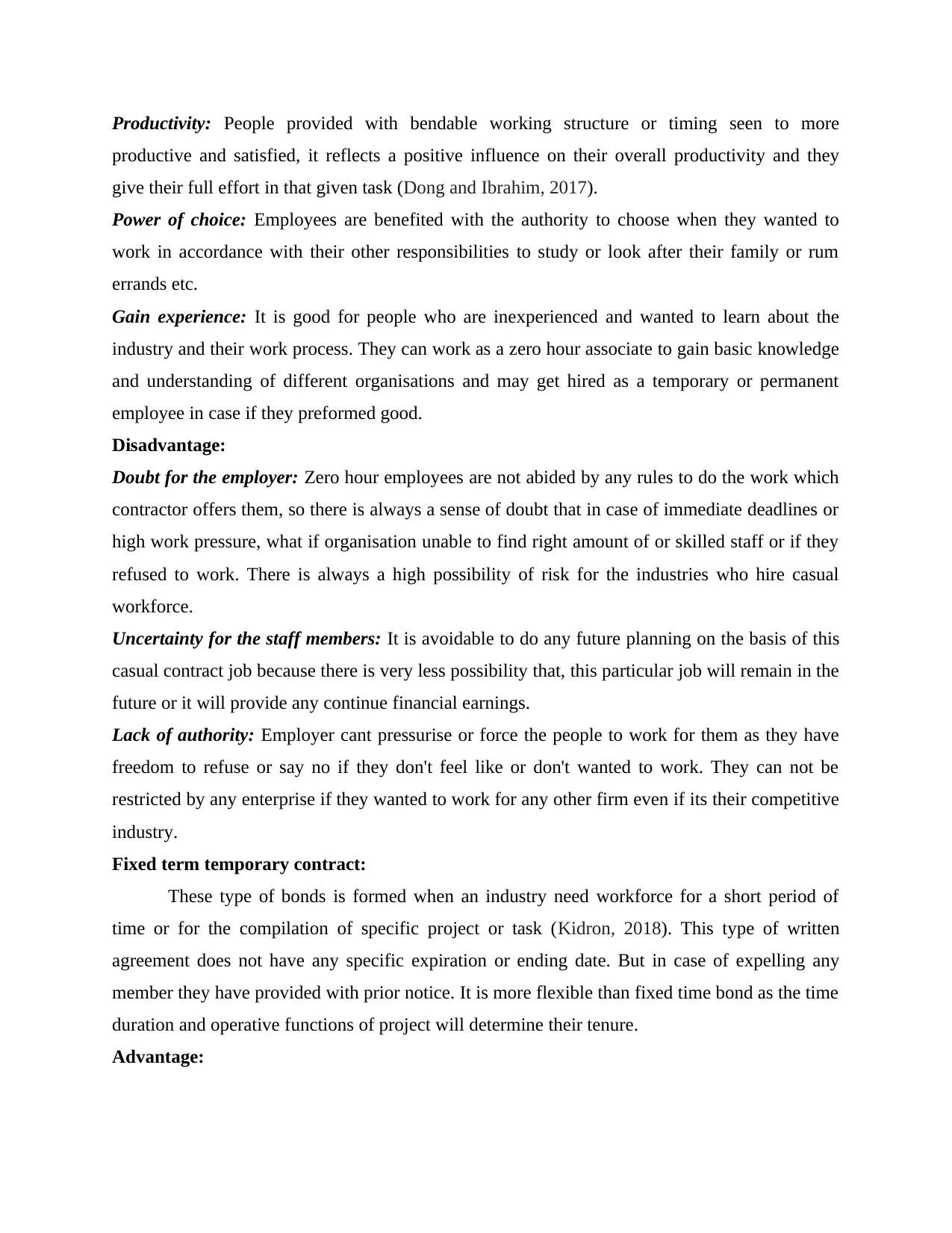
Productivity: People provided with bendable working structure or timing seen to more
productive and satisfied, it reflects a positive influence on their overall productivity and they
give their full effort in that given task (Dong and Ibrahim, 2017).
Power of choice: Employees are benefited with the authority to choose when they wanted to
work in accordance with their other responsibilities to study or look after their family or rum
errands etc.
Gain experience: It is good for people who are inexperienced and wanted to learn about the
industry and their work process. They can work as a zero hour associate to gain basic knowledge
and understanding of different organisations and may get hired as a temporary or permanent
employee in case if they preformed good.
Disadvantage:
Doubt for the employer: Zero hour employees are not abided by any rules to do the work which
contractor offers them, so there is always a sense of doubt that in case of immediate deadlines or
high work pressure, what if organisation unable to find right amount of or skilled staff or if they
refused to work. There is always a high possibility of risk for the industries who hire casual
workforce.
Uncertainty for the staff members: It is avoidable to do any future planning on the basis of this
casual contract job because there is very less possibility that, this particular job will remain in the
future or it will provide any continue financial earnings.
Lack of authority: Employer cant pressurise or force the people to work for them as they have
freedom to refuse or say no if they don't feel like or don't wanted to work. They can not be
restricted by any enterprise if they wanted to work for any other firm even if its their competitive
industry.
Fixed term temporary contract:
These type of bonds is formed when an industry need workforce for a short period of
time or for the compilation of specific project or task (Kidron, 2018). This type of written
agreement does not have any specific expiration or ending date. But in case of expelling any
member they have provided with prior notice. It is more flexible than fixed time bond as the time
duration and operative functions of project will determine their tenure.
Advantage:
productive and satisfied, it reflects a positive influence on their overall productivity and they
give their full effort in that given task (Dong and Ibrahim, 2017).
Power of choice: Employees are benefited with the authority to choose when they wanted to
work in accordance with their other responsibilities to study or look after their family or rum
errands etc.
Gain experience: It is good for people who are inexperienced and wanted to learn about the
industry and their work process. They can work as a zero hour associate to gain basic knowledge
and understanding of different organisations and may get hired as a temporary or permanent
employee in case if they preformed good.
Disadvantage:
Doubt for the employer: Zero hour employees are not abided by any rules to do the work which
contractor offers them, so there is always a sense of doubt that in case of immediate deadlines or
high work pressure, what if organisation unable to find right amount of or skilled staff or if they
refused to work. There is always a high possibility of risk for the industries who hire casual
workforce.
Uncertainty for the staff members: It is avoidable to do any future planning on the basis of this
casual contract job because there is very less possibility that, this particular job will remain in the
future or it will provide any continue financial earnings.
Lack of authority: Employer cant pressurise or force the people to work for them as they have
freedom to refuse or say no if they don't feel like or don't wanted to work. They can not be
restricted by any enterprise if they wanted to work for any other firm even if its their competitive
industry.
Fixed term temporary contract:
These type of bonds is formed when an industry need workforce for a short period of
time or for the compilation of specific project or task (Kidron, 2018). This type of written
agreement does not have any specific expiration or ending date. But in case of expelling any
member they have provided with prior notice. It is more flexible than fixed time bond as the time
duration and operative functions of project will determine their tenure.
Advantage:
⊘ This is a preview!⊘
Do you want full access?
Subscribe today to unlock all pages.

Trusted by 1+ million students worldwide
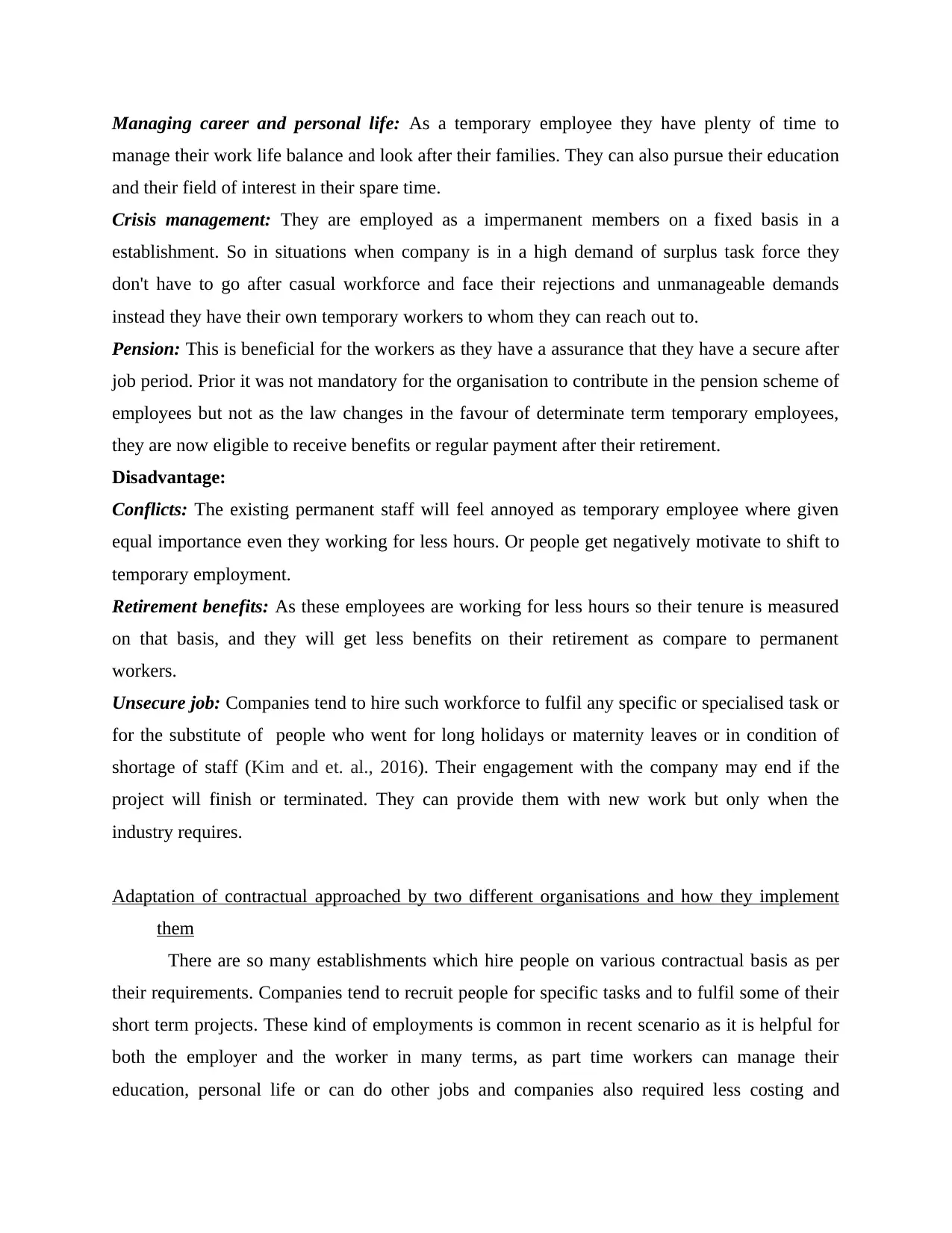
Managing career and personal life: As a temporary employee they have plenty of time to
manage their work life balance and look after their families. They can also pursue their education
and their field of interest in their spare time.
Crisis management: They are employed as a impermanent members on a fixed basis in a
establishment. So in situations when company is in a high demand of surplus task force they
don't have to go after casual workforce and face their rejections and unmanageable demands
instead they have their own temporary workers to whom they can reach out to.
Pension: This is beneficial for the workers as they have a assurance that they have a secure after
job period. Prior it was not mandatory for the organisation to contribute in the pension scheme of
employees but not as the law changes in the favour of determinate term temporary employees,
they are now eligible to receive benefits or regular payment after their retirement.
Disadvantage:
Conflicts: The existing permanent staff will feel annoyed as temporary employee where given
equal importance even they working for less hours. Or people get negatively motivate to shift to
temporary employment.
Retirement benefits: As these employees are working for less hours so their tenure is measured
on that basis, and they will get less benefits on their retirement as compare to permanent
workers.
Unsecure job: Companies tend to hire such workforce to fulfil any specific or specialised task or
for the substitute of people who went for long holidays or maternity leaves or in condition of
shortage of staff (Kim and et. al., 2016). Their engagement with the company may end if the
project will finish or terminated. They can provide them with new work but only when the
industry requires.
Adaptation of contractual approached by two different organisations and how they implement
them
There are so many establishments which hire people on various contractual basis as per
their requirements. Companies tend to recruit people for specific tasks and to fulfil some of their
short term projects. These kind of employments is common in recent scenario as it is helpful for
both the employer and the worker in many terms, as part time workers can manage their
education, personal life or can do other jobs and companies also required less costing and
manage their work life balance and look after their families. They can also pursue their education
and their field of interest in their spare time.
Crisis management: They are employed as a impermanent members on a fixed basis in a
establishment. So in situations when company is in a high demand of surplus task force they
don't have to go after casual workforce and face their rejections and unmanageable demands
instead they have their own temporary workers to whom they can reach out to.
Pension: This is beneficial for the workers as they have a assurance that they have a secure after
job period. Prior it was not mandatory for the organisation to contribute in the pension scheme of
employees but not as the law changes in the favour of determinate term temporary employees,
they are now eligible to receive benefits or regular payment after their retirement.
Disadvantage:
Conflicts: The existing permanent staff will feel annoyed as temporary employee where given
equal importance even they working for less hours. Or people get negatively motivate to shift to
temporary employment.
Retirement benefits: As these employees are working for less hours so their tenure is measured
on that basis, and they will get less benefits on their retirement as compare to permanent
workers.
Unsecure job: Companies tend to hire such workforce to fulfil any specific or specialised task or
for the substitute of people who went for long holidays or maternity leaves or in condition of
shortage of staff (Kim and et. al., 2016). Their engagement with the company may end if the
project will finish or terminated. They can provide them with new work but only when the
industry requires.
Adaptation of contractual approached by two different organisations and how they implement
them
There are so many establishments which hire people on various contractual basis as per
their requirements. Companies tend to recruit people for specific tasks and to fulfil some of their
short term projects. These kind of employments is common in recent scenario as it is helpful for
both the employer and the worker in many terms, as part time workers can manage their
education, personal life or can do other jobs and companies also required less costing and
Paraphrase This Document
Need a fresh take? Get an instant paraphrase of this document with our AI Paraphraser

operating cost in managing those staff. Sports direct and Amazon are two of the best example of
the enterprise who recruit staff on the basis of different employment approaches.
Amazon:
It is an international organisation based on technology. It was established in 1994 and
their main functions are cloud computing, A.I and digital marketing. They are also a global
retailer who deliver products at peoples door steps through their online websites. They have a
large network of distribution through which they cater a wide range of products ranging from
clothing, footwear, home & décor, furniture, stationary supplies, electronic equipments etc. As
this organisation basically operates online and have very fewer physical stores they need very
less operation cost and in less need of on the field employees (Mauno and Ruokolainen, 2017).
So, they follows different hiring methods bases on contracts apart from the permanent
employees. The type of recruitment they done is discussed below:
Zero hour employees: Amazon tend to hire casual workers as they operate in a wide range or
countries and regions and cater to customers all around the globe so its hard and a lot expensive
to hire fixed term employees in every little region or locations. Industry have established various
operational centres and alliances with courier and delivery corporation which operates for them.
They have some designated area managers but the remaining staff is on informal basis. The call
for these staff when they required agents and workers in a particular locations or if the order
demand is very high. Mainly they requires staffing in packaging and warehousing. They have
been paid according the duration and type of task they have performed.
Fixed term temporary contact staff members: These workers are hired by the management for a
shorter period of time, they have recruited on a fixed tenure but ending date may differ.
Administration at Amazon recruit skilled workers to fulfil their projects or use them as fillers in
if case their staff members were on leave or they need specialised people in their technology
department. This establishment is working in diversified sectors which need skilled and talented
people time to time but not on fixed terms (Mthimkulu, 2018). As the company operates online
they required temporary employees alliances with the company which can be called for help in
emergency or crisis situation.
Influence of these employment on the enterprise: The one and the best positive thing about that
is the overall operational and cost will be low. The procedure of recruitment of workers will be
sorted out and less investment is required on their management. Temporary workers are hired on
the enterprise who recruit staff on the basis of different employment approaches.
Amazon:
It is an international organisation based on technology. It was established in 1994 and
their main functions are cloud computing, A.I and digital marketing. They are also a global
retailer who deliver products at peoples door steps through their online websites. They have a
large network of distribution through which they cater a wide range of products ranging from
clothing, footwear, home & décor, furniture, stationary supplies, electronic equipments etc. As
this organisation basically operates online and have very fewer physical stores they need very
less operation cost and in less need of on the field employees (Mauno and Ruokolainen, 2017).
So, they follows different hiring methods bases on contracts apart from the permanent
employees. The type of recruitment they done is discussed below:
Zero hour employees: Amazon tend to hire casual workers as they operate in a wide range or
countries and regions and cater to customers all around the globe so its hard and a lot expensive
to hire fixed term employees in every little region or locations. Industry have established various
operational centres and alliances with courier and delivery corporation which operates for them.
They have some designated area managers but the remaining staff is on informal basis. The call
for these staff when they required agents and workers in a particular locations or if the order
demand is very high. Mainly they requires staffing in packaging and warehousing. They have
been paid according the duration and type of task they have performed.
Fixed term temporary contact staff members: These workers are hired by the management for a
shorter period of time, they have recruited on a fixed tenure but ending date may differ.
Administration at Amazon recruit skilled workers to fulfil their projects or use them as fillers in
if case their staff members were on leave or they need specialised people in their technology
department. This establishment is working in diversified sectors which need skilled and talented
people time to time but not on fixed terms (Mthimkulu, 2018). As the company operates online
they required temporary employees alliances with the company which can be called for help in
emergency or crisis situation.
Influence of these employment on the enterprise: The one and the best positive thing about that
is the overall operational and cost will be low. The procedure of recruitment of workers will be
sorted out and less investment is required on their management. Temporary workers are hired on

less salary as compared to permanent staff, and the casual workers are only get paid when they
perform any job work, they are paid on daily basis or on compilation of work otherwise the
expense of their salaries are saved. This will also facilitate the industry to start their operation in
new location as they can hire people on contract so they doesn't require bigger or more
established operation centre or guidance to manage.
Sports direct:
They are sports apparels and sport wear retailers who deal in delivering and providing
sport utility items and accessories like footwear, gym wears, active wearables now they are
expanding their business in fashion and style brands. This establishment basically works in
catering products of various renowned brands to customers all over the world, they basically act
as a warehouse or storage platform from companies through this they sell their products to
different stores and locations. Sports direct are the retailers which work for various corporations
like Adidas, Nike ,Puma etc. and some styling brands like Voodoo dolls, Rock & Rags,
Golddigga etc. They operate online as well as they have their physicals stores also. They done
employment by following various written agreement approaches. The type of method they use
for hiring is mentioned below:
Permanent part time workers: Industry recruit part timers on permanent contract. As they are in
need of employees who can work in flexible working conditions and bendable hours. They need
people to work in different shift timings according to the demand and sale (Plomp and et. al.,
2019). Company have engagement with various organisations so increase in their demand will
effect the working procedure of Sports direct, so they also recruit employees on part time along
with the fixed staff. Their working hour is little less then the permanent workers but they also
function 6-5 days a week.
Casual employees: Being a retail industry they need huge amount of associates to perform
various functions, but the need of certain work functions arises only on occasional purpose or
when demand is very high or they have conducted a sale or near occasions like Christmas or
other festivals. Company required people to promote or distribute fliers when they open any new
outlet or they need people to provide personalise service when a customer makes a purchase or to
deliver products at their door steps. Whenever the enterprise in need of fulfil these task they call
for the informal workforce to complete that assigned task and get paid in accordance with their
performance and ability.
perform any job work, they are paid on daily basis or on compilation of work otherwise the
expense of their salaries are saved. This will also facilitate the industry to start their operation in
new location as they can hire people on contract so they doesn't require bigger or more
established operation centre or guidance to manage.
Sports direct:
They are sports apparels and sport wear retailers who deal in delivering and providing
sport utility items and accessories like footwear, gym wears, active wearables now they are
expanding their business in fashion and style brands. This establishment basically works in
catering products of various renowned brands to customers all over the world, they basically act
as a warehouse or storage platform from companies through this they sell their products to
different stores and locations. Sports direct are the retailers which work for various corporations
like Adidas, Nike ,Puma etc. and some styling brands like Voodoo dolls, Rock & Rags,
Golddigga etc. They operate online as well as they have their physicals stores also. They done
employment by following various written agreement approaches. The type of method they use
for hiring is mentioned below:
Permanent part time workers: Industry recruit part timers on permanent contract. As they are in
need of employees who can work in flexible working conditions and bendable hours. They need
people to work in different shift timings according to the demand and sale (Plomp and et. al.,
2019). Company have engagement with various organisations so increase in their demand will
effect the working procedure of Sports direct, so they also recruit employees on part time along
with the fixed staff. Their working hour is little less then the permanent workers but they also
function 6-5 days a week.
Casual employees: Being a retail industry they need huge amount of associates to perform
various functions, but the need of certain work functions arises only on occasional purpose or
when demand is very high or they have conducted a sale or near occasions like Christmas or
other festivals. Company required people to promote or distribute fliers when they open any new
outlet or they need people to provide personalise service when a customer makes a purchase or to
deliver products at their door steps. Whenever the enterprise in need of fulfil these task they call
for the informal workforce to complete that assigned task and get paid in accordance with their
performance and ability.
⊘ This is a preview!⊘
Do you want full access?
Subscribe today to unlock all pages.

Trusted by 1+ million students worldwide
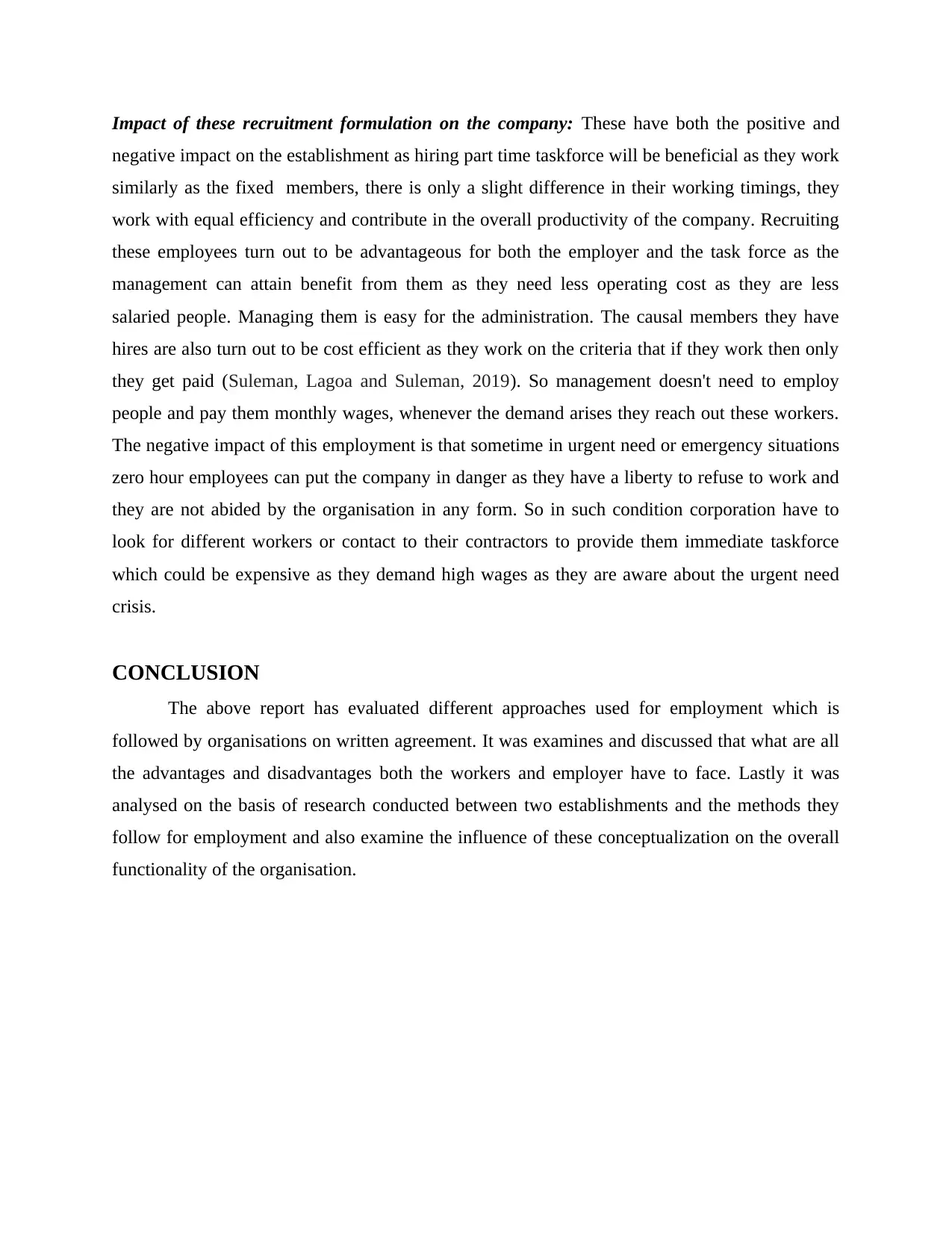
Impact of these recruitment formulation on the company: These have both the positive and
negative impact on the establishment as hiring part time taskforce will be beneficial as they work
similarly as the fixed members, there is only a slight difference in their working timings, they
work with equal efficiency and contribute in the overall productivity of the company. Recruiting
these employees turn out to be advantageous for both the employer and the task force as the
management can attain benefit from them as they need less operating cost as they are less
salaried people. Managing them is easy for the administration. The causal members they have
hires are also turn out to be cost efficient as they work on the criteria that if they work then only
they get paid (Suleman, Lagoa and Suleman, 2019). So management doesn't need to employ
people and pay them monthly wages, whenever the demand arises they reach out these workers.
The negative impact of this employment is that sometime in urgent need or emergency situations
zero hour employees can put the company in danger as they have a liberty to refuse to work and
they are not abided by the organisation in any form. So in such condition corporation have to
look for different workers or contact to their contractors to provide them immediate taskforce
which could be expensive as they demand high wages as they are aware about the urgent need
crisis.
CONCLUSION
The above report has evaluated different approaches used for employment which is
followed by organisations on written agreement. It was examines and discussed that what are all
the advantages and disadvantages both the workers and employer have to face. Lastly it was
analysed on the basis of research conducted between two establishments and the methods they
follow for employment and also examine the influence of these conceptualization on the overall
functionality of the organisation.
negative impact on the establishment as hiring part time taskforce will be beneficial as they work
similarly as the fixed members, there is only a slight difference in their working timings, they
work with equal efficiency and contribute in the overall productivity of the company. Recruiting
these employees turn out to be advantageous for both the employer and the task force as the
management can attain benefit from them as they need less operating cost as they are less
salaried people. Managing them is easy for the administration. The causal members they have
hires are also turn out to be cost efficient as they work on the criteria that if they work then only
they get paid (Suleman, Lagoa and Suleman, 2019). So management doesn't need to employ
people and pay them monthly wages, whenever the demand arises they reach out these workers.
The negative impact of this employment is that sometime in urgent need or emergency situations
zero hour employees can put the company in danger as they have a liberty to refuse to work and
they are not abided by the organisation in any form. So in such condition corporation have to
look for different workers or contact to their contractors to provide them immediate taskforce
which could be expensive as they demand high wages as they are aware about the urgent need
crisis.
CONCLUSION
The above report has evaluated different approaches used for employment which is
followed by organisations on written agreement. It was examines and discussed that what are all
the advantages and disadvantages both the workers and employer have to face. Lastly it was
analysed on the basis of research conducted between two establishments and the methods they
follow for employment and also examine the influence of these conceptualization on the overall
functionality of the organisation.
Paraphrase This Document
Need a fresh take? Get an instant paraphrase of this document with our AI Paraphraser

REFERENCES
Books and journals
Andrew Eldred, M.A., 2018. Implementing Contractual Skills and Employment Targets.
Bernhard‐Oettel, C and et. al., 2017. How Do We Feel and Behave When We're Not Permanent
Full‐Time Employees? The Case of the Diverse Forms of Non‐Standard Work. An
Introduction to Work and Organizational Psychology: An International Perspective,
pp.258-275.
De Cuyper, N and et. al., 2019. Job insecurity, employability and satisfaction among temporary
and permanent employees in post-crisis Europe. Economic and Industrial Democracy.
40(2). pp.173-192.
Dong, J. and Ibrahim, R., 2017. Flexible workers or full-time employees? On staffing systems
with a blended workforce. Working paper.
Kidron, A., 2018. Examining the Mediating Role of Commitment to the Supervisor in
Employees’ Affective Commitment: Temporary Employees Versus Permanent
Employees. Journal of Leadership & Organizational Studies. 25(4). pp.456-468.
Kim, W and et. al., 2016. Effect of working hours and precarious employment on depressive
symptoms in South Korean employees: a longitudinal study. Occupational and
environmental medicine.73(12). pp.816-822.
Mauno, S. and Ruokolainen, M., 2017. Does organizational work–family support benefit
temporary and permanent employees equally in a work–family conflict situation in
relation to job satisfaction and emotional energy at work and at home?. Journal of
Family Issues. 38(1).pp.124-148.
Mthimkulu, M.E., 2018. An analysis of implications of temporary contractual employment of
expatriate educators in public secondary schools in the South African education system
(Doctoral dissertation, University of Johannesburg).
Plomp, J and et. al., 2019. Psychological safety, job crafting, and employability: A comparison
between permanent and temporary workers. Frontiers in psychology.10.p.974.
Suleman, F., Lagoa, S. and Suleman, A., 2019. Patterns of employment relationships: the
association between compensation policy and contractual arrangements.The
International Journal of Human Resource Management. 30(7). pp.1136-1156.
11
Books and journals
Andrew Eldred, M.A., 2018. Implementing Contractual Skills and Employment Targets.
Bernhard‐Oettel, C and et. al., 2017. How Do We Feel and Behave When We're Not Permanent
Full‐Time Employees? The Case of the Diverse Forms of Non‐Standard Work. An
Introduction to Work and Organizational Psychology: An International Perspective,
pp.258-275.
De Cuyper, N and et. al., 2019. Job insecurity, employability and satisfaction among temporary
and permanent employees in post-crisis Europe. Economic and Industrial Democracy.
40(2). pp.173-192.
Dong, J. and Ibrahim, R., 2017. Flexible workers or full-time employees? On staffing systems
with a blended workforce. Working paper.
Kidron, A., 2018. Examining the Mediating Role of Commitment to the Supervisor in
Employees’ Affective Commitment: Temporary Employees Versus Permanent
Employees. Journal of Leadership & Organizational Studies. 25(4). pp.456-468.
Kim, W and et. al., 2016. Effect of working hours and precarious employment on depressive
symptoms in South Korean employees: a longitudinal study. Occupational and
environmental medicine.73(12). pp.816-822.
Mauno, S. and Ruokolainen, M., 2017. Does organizational work–family support benefit
temporary and permanent employees equally in a work–family conflict situation in
relation to job satisfaction and emotional energy at work and at home?. Journal of
Family Issues. 38(1).pp.124-148.
Mthimkulu, M.E., 2018. An analysis of implications of temporary contractual employment of
expatriate educators in public secondary schools in the South African education system
(Doctoral dissertation, University of Johannesburg).
Plomp, J and et. al., 2019. Psychological safety, job crafting, and employability: A comparison
between permanent and temporary workers. Frontiers in psychology.10.p.974.
Suleman, F., Lagoa, S. and Suleman, A., 2019. Patterns of employment relationships: the
association between compensation policy and contractual arrangements.The
International Journal of Human Resource Management. 30(7). pp.1136-1156.
11

12
⊘ This is a preview!⊘
Do you want full access?
Subscribe today to unlock all pages.

Trusted by 1+ million students worldwide
1 out of 12
Related Documents
Your All-in-One AI-Powered Toolkit for Academic Success.
+13062052269
info@desklib.com
Available 24*7 on WhatsApp / Email
![[object Object]](/_next/static/media/star-bottom.7253800d.svg)
Unlock your academic potential
Copyright © 2020–2025 A2Z Services. All Rights Reserved. Developed and managed by ZUCOL.





